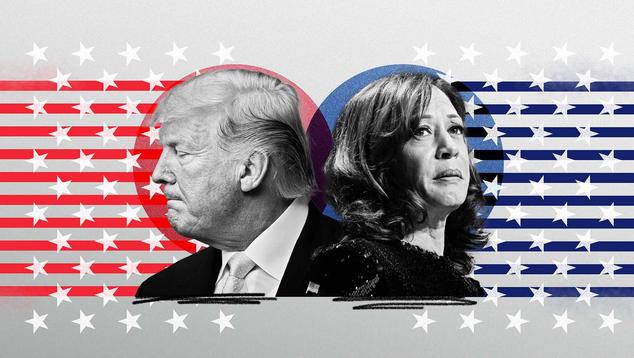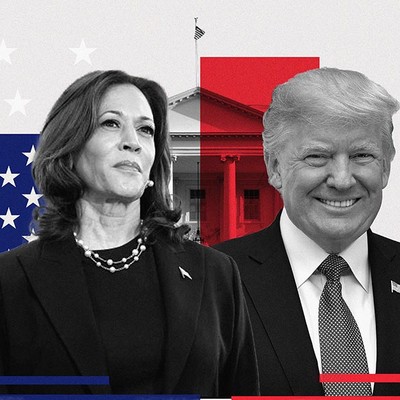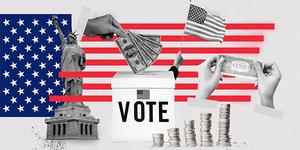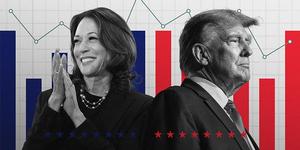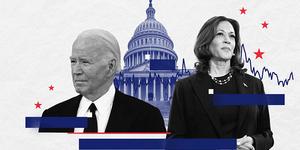WASHINGTON, D.C. -- About half of U.S. adults rate Donald Trump and Kamala Harris positively on a 10-point favorability scale. This puts them on the lower end of what Gallup has measured using this rating scale for presidential nominees dating back to 1956. Trump’s current rating is similar to what he received in 2020 but significantly better than his 36% positive score in 2016, which is the record low.
These results are based on an Oct. 1-12 Gallup poll that asked Americans to rate the two major-party presidential nominees on a scale ranging from +5 to -5, something it has done in all presidential election years except 1988, 1996 and 2000. Gallup used this “scalometer” to measure favorability toward national figures until the 1990s, when it shifted to using a binary favorable/unfavorable scale. Gallup’s latest measure of the two nominees using the binary rating scale, from late September, also shows them closely matched, with 48% favorable for Harris and 47% for Trump.
This is the first time in Trump’s three presidential campaigns that his scalometer rating has not been below 50% positive. In addition to Trump in 2016 and 2020 and Harris this year, Hillary Clinton in 2016 and Barry Goldwater in 1964 are the other candidates with sub-50% positive ratings.
Historically, most presidential candidates have had positive ratings of 60% or higher. This includes several losing candidates such as Adlai Stevenson in 1956, Richard Nixon in 1960, Hubert Humphrey in 1968, Jimmy Carter in 1980, Walter Mondale in 1984 and John McCain in 2008.
In recent presidential elections, Americans have been less charitable in their ratings of the nominees. Among the 12 presidential nominees since 2004, only Barack Obama (2008 and 2012), McCain (2008) and George W. Bush (2004) have reached the 60%+ positive threshold.
Polarized Attitudes Apparent in Ratings of Both 2024 Candidates
More Americans give Trump and Harris highly positive or highly negative ratings than either moderately positive or moderately negative ratings. Both candidates also receive a larger share of highly negative than highly positive ratings.
Overall, 31% have a highly favorable opinion of Trump (a rating of +4 or +5), while 37% have a highly unfavorable opinion of him (a rating of -4 or -5). Thirty percent offer moderate ratings of Trump, including 19% positive and 11% negative.
For Harris, 30% have a highly positive opinion of her and 34% a highly negative one, with 34% choosing a moderate rating (18% positive and 16% negative).
Before 2016, no major-party candidate had exceeded a 26% highly unfavorable rating (third-party candidate George Wallace in 1968 was at 32%). But during all three of his presidential campaigns, Trump has exceeded 30%, as Hillary Clinton did in 2016 and Harris has this year.
Highly favorable ratings of 30% or above are common, as slightly more than half (17 of 30) of the major-party nominees Gallup has measured have been rated that well. Dwight Eisenhower in 1956 (57%), Lyndon Johnson in 1964 (49%), John Kennedy in 1960 (43%) and Ronald Reagan in 1984 (43%) had the largest percentages of highly favorable ratings. Third-party candidate John Anderson in 1980 (11%), Trump in 2016 (14%), Goldwater in 1964 (17%) and Wallace in 1968 (18%) had the lowest.
Partisans Rate Own Candidate Very Highly, Opponent Very Negatively
As would be expected, the highly positive ratings of Trump and highly negative ratings of Harris primarily come from Republicans, while the highly positive ratings of Harris and highly negative ratings of Trump come from Democrats.
Both candidates receive similar highly favorable ratings from their own party’s supporters (68% for Trump among Republicans, 72% for Harris among Democrats) and from independents (21% for both candidates). However, Trump gets more highly unfavorable ratings than Harris from the opposing party (80% vs. 71%, respectively) and independents (35% vs. 29%).
This is the first time a candidate has been viewed highly unfavorably by as much as 80% of supporters of the opposing party, though Trump in 2020 (78%) and Hillary Clinton in 2016 (79%) came close. Harris and Trump (in 2016) are the only other candidates whose highly unfavorable score from the opposition has exceeded 70%.
Such strong negative reactions from the opposing party have not been the norm historically. In the 1980 through 2012 elections in which Gallup collected scalometer ratings, presidential nominees averaged 38% highly unfavorable ratings from the opposing party’s supporters. And from 1956 through 1976, the average was just 17%.
Underscoring the extreme partisan polarization in views of political figures these days, Trump’s and Harris’ highly favorable ratings from their own party’s supporters also rank near the top historically. In fact, Harris’ 72% highly favorable rating from Democrats ties with Barack Obama’s in 2008 as the highest for a Democratic presidential candidate.
Reagan’s 76% highly favorable rating from Republicans in 1984 is the highest for any candidate from either party. Trump’s 73% from Republicans in 2020 is the second highest, slightly above his 68% this year.
Bottom Line
Trump and Harris are campaigning for president while Americans' opinions of them are on the low end of what Gallup has measured for presidential nominees. Trump’s image is markedly better than it was in 2016, when he set a new standard for unpopularity but won the election anyway. His ratings are similar to what they were in 2020 when he was defeated for a second term.
Both candidates are rated strongly positively by their own party and strongly negatively by the opposition. That intensity could play a role in getting Americans to turn out. If it does, it may work to Harris’ advantage, given higher strongly negative ratings for Trump among Democrats and independents than for Harris among Republicans and independents. That dynamic was apparent in 2016 when Hillary Clinton had higher strongly negative ratings than Trump did, even though Clinton was rated better among Americans overall. In 2020, it was Trump who had higher strongly negative ratings and lost to his opponent Joe Biden.
To stay up to date with the latest Gallup News insights and updates, follow us on X @Gallup.
Learn more about how the Gallup Poll Social Series works.
View complete question responses and trends (PDF download).
